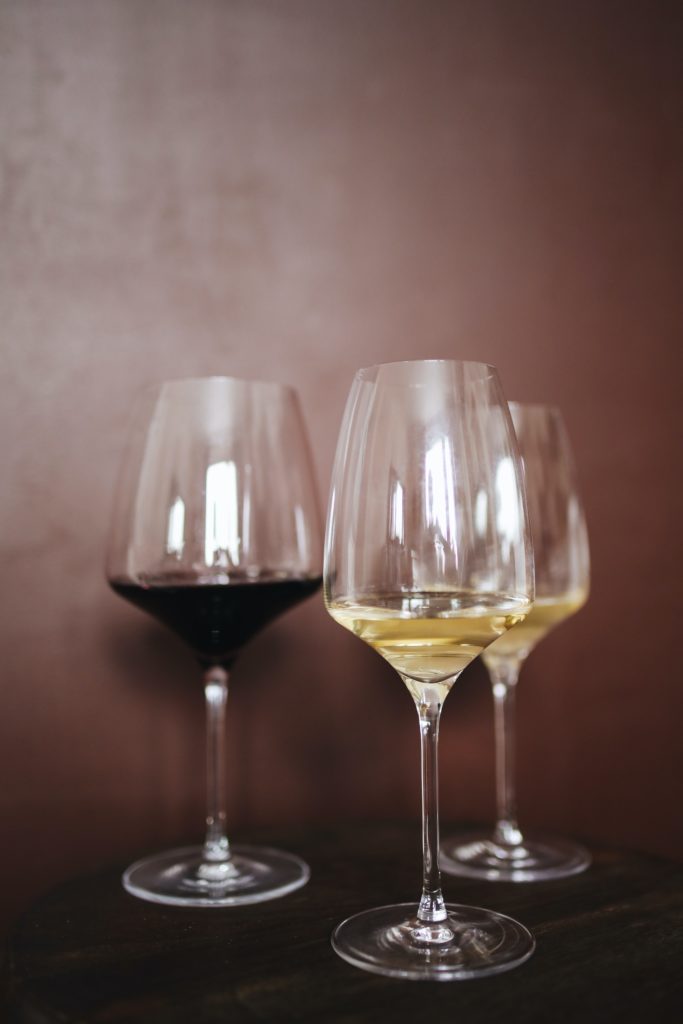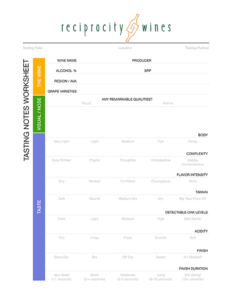TASTING PROFILES DECIPHERED
BEFORE WE JUMP INTO WHAT WE MEAN BE EACH TERM…
Let’s look at why we even take tasting notes and why should you get in the habit of doing so yourself.
First off, we do tastings and take copious notes to determine not only if we want to bring certain wines onboard, but also the more information we can convey to you our customers the better. We believe in not only meeting your expectations but exceeding them, and that knowledge is power. The more you know and understand about a wine the more empowered you are as a consumer. In addition, we want you to love the wines you are buying! By fully understanding the tasting profile of a wine, you should have a much better idea of what will arrive on your doorstep.

WHY SHOULD YOU GO THROUGH THE PRACTICE OF DOING TASTING NOTES?
As you learn more about your palate and become better informed about what you like and don’t like, you can convey those terms, in wine terminology, to a Somm at a restaurant or wine shop and be happier with your selections. Getting in the habit of critically identifying characteristics of wines helps you to learn overall and have a greater appreciation for what’s in your glass!
It’s also really fun to do this with a few friends and compare and contrast your findings.
See WSET’s (Wine & Spirit Education Trust) tasting descriptors, levels 2-4.
CONVINCED YET?
Feel free to refer to and use our own tasting notes worksheet that we developed and use every time we set-up one of our tastings.
Although we have made the worksheet very user friendly, this article will help to further define and explain how we use the terms we are referencing. You will notice some categories are fairly typical while others are seemingly arbitrary, but we feel they fall in line with describing how the wine is experienced. Where WSET’s approach is academic and focused on judging the overall quality, just because a wine is of good quality doesn’t necessarily mean you will like it. We want you to be able to identify what you like and feel confident about it.
While a lot of wine terms can be somewhat intimidating, we embrace making wine and wine education, as easy to understand as possible. Sure Rip-your-face-off tannins and Oak-bomb! levels may not be in your everyday vernacular… but they should be!
TASTING PROFILE CATEGORIES
Body: The body of wine is often a term used to describe a style of wine. According to Madeline
Puckette of Wine Folly and author of The Essential Guide to Wine: “Body is not a scientific term, but a categorization of style from lightest to boldest. The four characteristics of sweetness, acidity, tannin and alcohol affect how light or bold a wine will taste. She makes a great analogy of light to full body by comparing skim to whole milk. Like the example of milk a lot about the body of the wine come from the viscosity (aka, thickness) of the liquid and the heavier the liquid feels the fuller the body it is perceived to have.
Very-light
Light
Medium
Full
Heavy
Complexity: So this is our favorite and least scientific of all of our tasting criteria! It’s about how serious of a wine do we want to be drinking. Some wines you can drink without giving them a second thought. Of course they are delicious but they aren’t complicated and they go down damn easy! Like you finish the bottle before you know it (guilty). Others, when you take a sip you just have to pause and go what the heck is happening in my mouth! Wine for us is about the mood. Sometimes it’s Friday night and we just want to open something non-complicated so a porch pounder it is. Other evenings we want to thoughtfully pair a wine with a delicious meal and share with our wine loving friends. A deeply contemplative wine may be in order so you can geek out over the nuances of the amazingness in your glass.
Easy-drinker
Playful
Thoughtful
Introspective
Deeply-contemplative
Flavor Intensity: Similar to Body but speaks to more of how the wine hits your palate. This is definitely not a category found on a Somm’s test. It falls in the more irreverent category but we like it to help to convey how intense we feel the wine is as we taste it.
Shy
Modest
Confident
Courageous
Bold
Tannin: Tannins are perceived as astringency or the pucker-effect of wine. It can feel like it is sucking the spit out of your mouth. For this criteria we are classifying the experience of tannins on the palate, more in line with the mouthfeel or texture pf the wine. Tannins come from two different sources. A majority of the tannins you taste in wine are from the grapes themselves (skins, seeds and stems or fruit tannins). The other tannins you may pick up on are from the oak barrels the wine was aged in, or barrel tannins. The newer the oak barrel the more tannin infiltration into the wine. Typically younger wines have higher tannin levels and older wines are softer. Tannins are also way more predominant in red wines because red wines are ages on the skins and seeds vs white wines are not. Some whites such as Chardonnay will have some tannins but that comes from oak tannins if they were aged in oak barrels.
Soft
Round
Medium-dry
Dry
Rip-your-face-off
Detectable Oak Levels: While a slightly more difficult category to identify especially for red wines which have inherent tannins from the fruit. This flavor profile is to help discern “oakiness” for white wines or reds that had a substantial amount of new barrel aging on them that is detectable above the fruit tannins. This can be where we begin to taste the different toasted profiles of the barrel such as vanilla, caramel, coffee, espresso and tobacco. This flavor profile will not be present if it is a wine that was aged on stainless steel or concrete.
Faint
Light
Medium
High
Oak-bomb!
Acidity: Acidity is the tart or sour flavors we perceive as we are drinking wine. Wine typically has a pH of 2.5 – 4.5. The lower the number the more acidic the wine is. For a reference water is roughly a 7.0 pH or neutral. In general acidity correlates to climates and how ripe the fruit was able to get for that vintage. A cooler climate will produce a higher acid wine as it is more challenging to fully ripen the fruit and a warmer climate where fruit easily ripens will tend to give you a less acidity and more fruit forward wines. Still trying to figure out what is acidity…it’s how your mouth feels. Does the wine feel like it’s really tart and making your mouth water? More Acid…Or does the wine feel very smooth and to the extreme flabby and completely lacking in tartness? Less Acid.
Tart
Crisp
Fresh
Smooth
Soft
Finish: This refers to the dry vs. sweet profiles of the wine, what you taste AFTER you swallow. Either you get a dry/ clean sensation in your mouth or you taste sugar on your palate. Sometimes tasters can confuse big fruit in the wine as sweetness but to call a wine sweet is to convey actual residual sugar (RS) in the flavors. A greater explanation of this is written here by TheyDiffer.com. They explain that dry wines are those that have less that 1% RS and sweet wines contain 20% or more RS. We offer an expansion on this concept with our scale as shown below.
Bone-dry
Dry
Off-dry
Sweet
It’s Dessert!
Finish Duration: This identifier is pretty straight-forward. How long did the finish remain on our palate after we swallowed it. Some wines will linger for what seems like hours on the palate and others disappear the moment they go down. You will find a correlation between this criteria and the Complexity category. We identify the finish duration based on length of time on out palate in seconds.
Very short
(<1 seconds)
Short
(2-4 seconds)
Moderate
(3-5 seconds)
Long
(6-10 seconds)
Still-going!
(10+ seconds)




